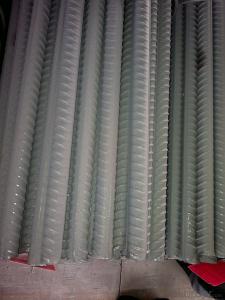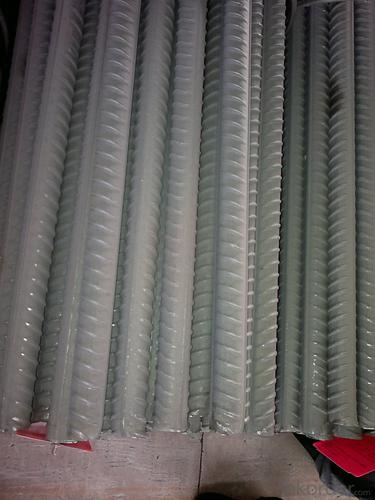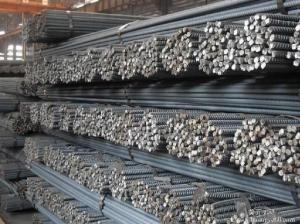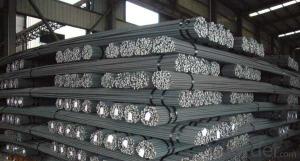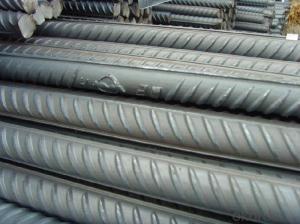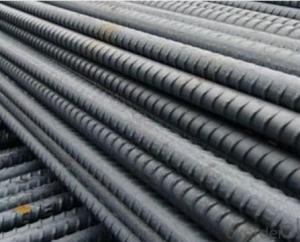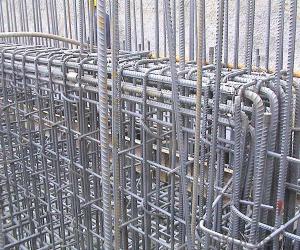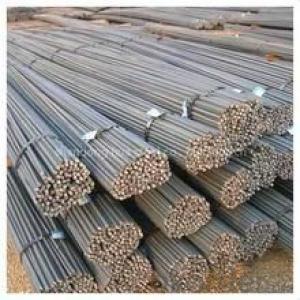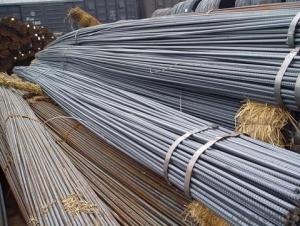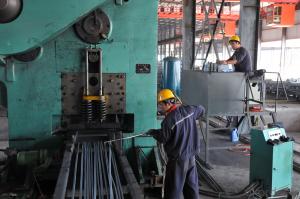Deformed Steel Bar, Concrete Reinforcing Steel Rebars
- Loading Port:
- China main port
- Payment Terms:
- TT or LC
- Min Order Qty:
- 100 m.t.
- Supply Capability:
- 100000 m.t./month
OKorder Service Pledge
OKorder Financial Service
You Might Also Like
Product Description:
OKorder is offering Deformed Steel Bar, Concrete Reinforcing Steel Rebars at great prices with worldwide shipping. Our supplier is a world-class manufacturer of steel, with our products utilized the world over. OKorder annually supplies products to African, South American and Asian markets. We provide quotations within 24 hours of receiving an inquiry and guarantee competitive prices.
Product Applications:
Deformed Steel Bar, Concrete Reinforcing Steel Rebars are ideal for structural applications and are widely used in the construction of buildings and bridges, and the manufacturing, petrochemical, and transportation industries.
Product Advantages:
OKorder's Deformed Steel Bar, Concrete Reinforcing Steel Rebars are durable, strong, and wide variety of sizes.
Main Product Features:
· Premium quality
· Prompt delivery & seaworthy packing (30 days after receiving deposit)
· Can be recycled and reused
· Mill test certification
· Professional Service
· Competitive pricing
Product Specifications:
Manufacture: Hot rolled
Grade: HRB335,HRB400,HRB500
Certificates: ISO, SGS, BV, CIQ
Length: 6m – 12m, as per customer request
Packaging: Export packing, nude packing, bundled
| DEFORMED BAR | |
| SIZE d(mm) | theoretical kg/m |
| 6 | 0.222 |
| 8 | 0.395 |
| 10 | 0.617 |
| 12 | 0.888 |
| 14 | 1.21 |
| 16 | 1.58 |
| 18 | 2 |
| 20 | 2.47 |
| 22 | 2.98 |
| 25 | 3.85 |
| 28 | 4.83 |
| 32 | 6.31 |
FAQ:
Q1: what is the difference between actual weight and theoretical weight?
A1: All the section steel has two weights: actual weight and theoretical weight. Actual weight is the weighing out when the product delivered from the mill. Theoretical weight is calculated by pieces. The invoice can be based on each of them as your request.
Q2: How do we guarantee the quality of our products?
A2: We have established an advanced quality management system which conducts strict quality tests at every step, from raw materials to the final product. At the same time, we provide extensive follow-up service assurances as required.
Q3: How soon can we receive the product after purchase?
A3: Within three days of placing an order, we will arrange production. The normal sizes with the normal grade can be produced within one month. The specific shipping date is dependent upon international and government factors, the delivery to international main port about 45-60days.
Images:
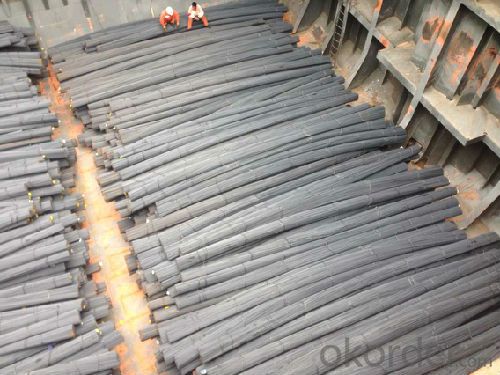
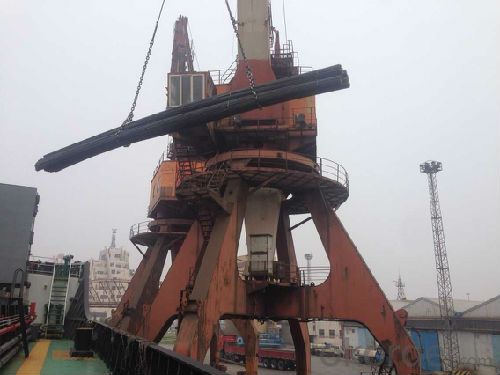
- Q: What are the different types of steel rebars used in industrial warehouses?
- There are typically two main types of steel rebars used in industrial warehouses: carbon steel rebars and epoxy-coated rebars. Carbon steel rebars are the most common and widely used type, known for their strength and durability. Epoxy-coated rebars, on the other hand, have a protective coating applied to prevent corrosion, making them suitable for warehouses exposed to moisture or corrosive environments.
- Q: Are there any health and safety concerns related to steel rebars?
- Yes, there are potential health and safety concerns related to steel rebars. Handling and working with steel rebars can pose risks such as cuts, injuries from falling or displaced rebars, and musculoskeletal disorders due to heavy lifting or repetitive movements. Additionally, workers may be exposed to hazards during the fabrication process, such as welding fumes or noise pollution. Adequate safety measures, including personal protective equipment and proper training, should be implemented to mitigate these risks and ensure a safe working environment.
- Q: What is the process of reinforcing concrete columns with steel rebars?
- The process of reinforcing concrete columns with steel rebars involves several steps. First, the design and layout of the rebars are determined based on the structural requirements and load calculations. Then, the concrete formwork is constructed to shape the column. Next, the rebars, typically made of high-strength steel, are placed in the formwork according to the designed layout, ensuring proper spacing and alignment. The rebars are often tied together using wire or mechanical connectors to maintain their position during the concrete pouring. Once the rebars are securely in place, concrete is poured into the formwork, encasing the rebars and forming the column. The concrete is then left to cure and harden, creating a strong and durable composite structure of concrete and steel.
- Q: What are the main uses of steel rebars?
- Steel rebars, also known as reinforcing bars, are primarily used in construction and civil engineering projects to provide strength and stability to concrete structures. The main uses of steel rebars include: 1. Reinforcing Concrete: Steel rebars are embedded within concrete structures to enhance their tensile strength. Concrete is excellent at withstanding compressive forces, but it is weak in tension. By adding rebars, the composite material formed (reinforced concrete) can resist both compressive and tensile forces, making it suitable for various applications such as building columns, beams, slabs, and foundations. 2. Structural Stability: Steel rebars play a crucial role in enhancing the structural stability of buildings and infrastructure. They help distribute the load evenly across the structure, preventing cracks, sagging, or collapse. By reinforcing concrete elements with rebars, structures can withstand heavy loads, seismic activity, and other external forces. 3. Bridges and Highways: Steel rebars are extensively used in the construction of bridges and highways. Bridges, being subjected to significant loads and harsh environmental conditions, require strong and durable reinforcement. Steel rebars ensure the longevity and structural integrity of these critical infrastructure projects. 4. Retaining Walls and Tunnels: Retaining walls are designed to hold back soil or other materials and prevent erosion. Steel rebars are commonly used to reinforce these structures, enabling them to withstand the lateral pressures exerted by the retained material. Similarly, in tunnel construction, rebars provide strength to the concrete lining, ensuring stability and preventing collapse. 5. Foundations: Steel rebars are a vital component in the construction of building foundations. They help distribute the weight of the structure evenly to the ground, preventing settlement or sinking. Moreover, rebars help anchor the foundation to the ground, providing stability against soil movement or seismic forces. 6. Pre-stressed and Post-tensioned Concrete: In pre-stressed and post-tensioned concrete construction, steel rebars are used to introduce compressive forces into the concrete members. This technique enhances the structural performance by reducing tensile stress, increasing load-bearing capacity, and minimizing cracking. 7. Masonry Reinforcement: Steel rebars are also utilized to reinforce masonry structures like walls, columns, and arches. By embedding rebars within the mortar joints or cores, the overall strength and stability of the masonry system are improved, allowing it to resist lateral loads and seismic forces. In summary, steel rebars are indispensable in modern construction, providing strength, stability, and durability to concrete structures. With their ability to resist tensile forces, they ensure the safety and longevity of buildings, bridges, highways, tunnels, and other essential infrastructure projects.
- Q: Can steel rebars be used in retrofitted structures?
- Yes, steel rebars can be used in retrofitted structures. Steel rebars are commonly used in retrofitting projects to strengthen existing structures and improve their load-bearing capacity. The addition of steel rebars can help reinforce the structure, increase its durability, and prevent further deterioration.
- Q: What are the advantages of using stainless steel rebars?
- Using stainless steel rebars in construction projects offers several advantages. Firstly, these rebars have a remarkable resistance to corrosion, making them perfect for structures in harsh environments such as coastal or industrial areas. Unlike traditional carbon steel rebars, stainless steel rebars do not easily rust or corrode, ensuring the durability and longevity of the structure. Secondly, stainless steel rebars possess a higher tensile strength compared to carbon steel rebars. This means they can endure greater stress and loads without deforming or breaking, resulting in a safer and more reliable structure. Moreover, their high tensile strength allows for the utilization of smaller rebars, which saves construction costs and reduces the overall weight of the structure. Furthermore, stainless steel rebars exhibit excellent fire resistance properties. They retain their strength and integrity much better than carbon steel in the event of a fire, reducing the risk of structural collapse. This is particularly crucial in buildings with high fire safety requirements, such as hospitals, schools, and high-rise structures. Another advantage of stainless steel rebars is their low maintenance requirements. Due to their corrosion resistance, they do not need regular inspections or costly protective coatings. This saves both time and money in maintenance efforts. Lastly, stainless steel rebars are highly sustainable and environmentally friendly. They are 100% recyclable, reducing the demand for new raw materials and minimizing waste in construction projects. Additionally, the long lifespan of stainless steel rebars reduces the need for frequent replacements, further minimizing the environmental impact. To summarize, the benefits of using stainless steel rebars include excellent corrosion resistance, high tensile strength, superior fire resistance, low maintenance requirements, and sustainability. These advantages make stainless steel rebars the preferred choice for construction projects that prioritize durability, safety, and long-term value.
- Q: Can steel rebars be used in the construction of shopping malls?
- Yes, steel rebars can be used in the construction of shopping malls. Steel rebars provide structural strength and reinforcement to concrete, making them suitable for use in various construction projects, including shopping malls.
- Q: How are steel rebars cut and bent on-site?
- Specialized tools and equipment are utilized on-site to cut and bend steel rebars. The process typically consists of the following steps: 1. Measurement: The rebars are measured according to the specified length and dimensions in the construction plans. This step is crucial to ensure precise and accurate cutting and bending. 2. Cutting: Various tools, such as manual rebar cutters, hydraulic shears, or portable electric cutters, are employed to cut the rebars. These tools are designed to make clean and precise cuts without damaging the rebars. The rebars are securely positioned, and the cutting tool is applied to the marked area to achieve the desired length. 3. Bending: Once the rebars are cut to the required length, they are bent using rebar benders. These machines possess different attachments and rollers to shape the rebars into the desired angle and radius. The rebars are cautiously positioned and secured in the bender, and the machine exerts force to bend them according to the specified shape. 4. Quality control: Following the cutting and bending stages, quality control checks are conducted to ensure that the rebars meet the required specifications. This may include visual inspections, measurements, and testing to verify the accuracy of dimensions and the quality of cuts and bends. It is important to note that skilled workers, such as ironworkers or steel fixers, typically assume responsibility for on-site rebar cutting and bending. They possess the expertise to interpret construction plans, utilize the appropriate tools, and guarantee the accurate cutting and bending of rebars to meet the project's requirements.
- Q: What is the effect of steel rebars on the electrical conductivity of concrete?
- Concrete's electrical conductivity is significantly influenced by steel rebars. The inclusion of steel rebars in concrete enhances its overall electrical conductivity as steel is an excellent conductor. This is because steel rebars create a network of conductive paths within the concrete, facilitating the smooth flow of electrical current. Considering the electrical conductivity of concrete is crucial, particularly in situations that necessitate electrical grounding or conductivity. Steel rebars play a vital role in establishing a low-resistance pathway for electrical current, enhancing the overall electrical conductivity of the concrete structure. Nevertheless, it is important to acknowledge that the presence of steel rebars can pose challenges in certain scenarios. For instance, in electrical installations requiring insulation or areas where electrical isolation is essential, the conductivity provided by steel rebars may not be desired. In such cases, additional measures such as insulation or isolation techniques must be employed to prevent undesired electrical currents from traversing through the concrete. In conclusion, the impact of steel rebars on the electrical conductivity of concrete is contingent upon the specific requirements and applications of the concrete structure. A thorough understanding of the intended use and the implementation of appropriate measures will ensure that the electrical conductivity of the concrete meets the desired specifications.
- Q: What is the role of steel rebars in preventing concrete cracking?
- The role of steel rebars in preventing concrete cracking is to provide reinforcement and strength to the concrete structure. By adding steel rebars, which are embedded within the concrete, it helps distribute the tensile forces and resist cracking caused by shrinkage, temperature changes, and external loads. The rebars act as a skeletal framework, enhancing the overall durability, stability, and resistance to cracking of the concrete.
Send your message to us
Deformed Steel Bar, Concrete Reinforcing Steel Rebars
- Loading Port:
- China main port
- Payment Terms:
- TT or LC
- Min Order Qty:
- 100 m.t.
- Supply Capability:
- 100000 m.t./month
OKorder Service Pledge
OKorder Financial Service
Similar products
Hot products
Hot Searches
Related keywords
